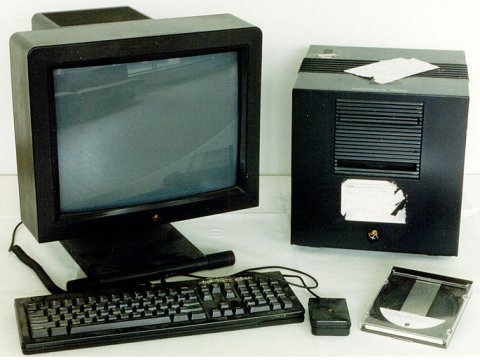| Author: | |
| Website: | |
| Page title: | |
| URL: | |
| Published: | |
| Last revised: | |
| Accessed: |
In March 1989 Tim Berners-Lee, a computer scientist working at the European Organisation for Nuclear Research (CERN) in Geneva, Switzerland, put forward a proposal for an electronic information management system which he formally published, with the help of colleague Robert Cailliau, in November 1990. His proposal described a distributed information storage and retrieval system. The information took the form of hypertext documents, which were created using a standard markup language. Copies of documents were retrieved from a remote server via the Internet and displayed on a computer screen using a program called a browser.
The term hypertext referred to the presence within the body of the document's text of embedded hyperlinks. A hyperlink is an item of text that contains the address of another document, either on the same computer or on another computer somewhere on the Internet. The user could retrieve a hyperlinked document by highlighting the hyperlink text and hitting the ENTER key. The mechanism (or access protocol) by which these documents were retrieved became known as the HyperText Transfer Protocol (HTTP). The NeXT computer pictured below was a high-end workstation, and was used by Berners-Lee to set up the world's first Internet web server (and to create the first web browser, which he called "WorldWideWeb").

This NeXT computer was the world's first web server
The World Wide Web became a publicly available Internet service in August 1991, and the first server outside of Europe was set up in the US at the Stanford Linear Accelerator Center (SLAC) in December of the same year. Although the basic concept of hypertext had been around since the 1960s, it was Berners-Lee's idea to apply the concept to the Internet. He subsequently developed a system of assigning a globally unique identifier to every Internet resource that became known as a Uniform Resource Identifier (URI). The web was designed to allow web pages to be automatically retrieved from a web server using a one-way link that required no action to be taken by the owner of the resource, thus greatly simplifying the design of both web browser and web server software. The non-proprietary nature of the system encouraged the development of web software and the deployment of web servers throughout the Internet, and in April 1993 CERN publicly announced that the World Wide Web would be available as a service to anyone, free of charge.
The probable turning point for the web in terms of it becoming more widely used was the development of the Mosaic web browser in 1993 by a team at the National Center for Supercomputing Applications (NCSA) at the University of Illinois. The team was led by Marc Andreessen, and the browser they created was the first to enable graphic images to be displayed in a web page. Andreessen and James H Clark, a former CEO of Silicon Graphics, met and subsequently formed the Mosaic Communications Corporation to develop the Mosaic browser commercially. The company was renamed Netscape Communications Corporation early in 1994, and subsequent versions of Mosaic were called Netscape Navigator. In October 1994 Berners-Lee, having left CERN, founded the World Wide Web Consortium (W3C), which was based at the Massachusetts Institute of Technology (MIT). The consortium included a number of companies with an interest in creating open standards and making recommendations for the future development of web technology.
By 1996 it was becoming apparent to many commercial organisations that a web presence was becoming highly desirable, particularly as web technology had by now evolved to the point where a two-way interaction between web clients and web servers made web-based commerce a real possibility. The rapid rise of the web-based enterprise led to the so-called dot.com boom of the late 1990s that was driven by great expectations and low interest rates. For many would-be Internet entrepreneurs, the venture capital ran out before the profits materialised, often due to poorly thought-out or executed business plans. Inevitably, the bubble burst in 2001, and many of these ill-fated ventures went out of business.
The resulting over-capacity of telecommunications companies (due to the loss of much of their customer base), together with the ongoing investment in mobile phone technology, helped to keep connection charges low and fuelled the development of affordable broadband Internet access. Survivors of the dot.com boom-and-bust, together with newcomers with somewhat more robust and sustainable business models, started to achieve considerable success. Companies such as Google, eBay and Amazon have become virtual household names, while social networking websites such as MySpace and Facebook have become an important element of youth culture. The web, once the domain of scientists and academics, has now become highly commercialised, and is ubiquitous in everyday life.